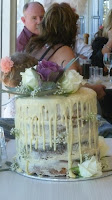DISCLOSURE: I purchased a copy of Nicholas Nickleby by Charles Dickens to read on this trip, and the composition of this entry is a poor imitation of his writing style. Forgive my presumption.)

Travel by train requires an attitude and a set of expectations that are shared generally by pensioners and lunatics. Not wishing to classify myself in either category, I must nevertheless say this latest sojourn into the transportation choice of a different era has been a delightful experience that we had more or less anticipated all along. We started in Sydney last Wednesday afternoon when we made our way to Central Station to await the departure of our mobile steel hotel. The night before we had stayed in a hostelry adjacent to the station which was comfortable if soulless, and we awaited check-in time with real excitement. Unfortunately, our first impressions were less than stellar. The efficient crew checked our luggage and invited us back to the platform an hour prior to departure in order to enjoy "canapes, drinks, and entertainment." The entertainment consisted of a guitar strumming crooner who resembled someone's uncle seated at the end of of a Thanksgiving dinner table, and his choice of musical performances consisted of some of the very worst of American

pop music from the sixties and seventies, delivered with a panache that was not improved by his enthusiasm. The drinks consisted of sparkling lemonade or bottled water, and the canapes were cold assemblages of canned vegetables and lunchmeat served on a curved cracker that could be easily concealed by a fifty cent piece. A rather inauspicious start, to be sure.
By now my impatient reader will protest mightily that the above described incidents betray the mood set by the opening sentences of the paragraph. Let me hasten to assure you that all doubts about the wisdom of undertaking a rail journey across the continent of Australia vanished the moment we were directed to our cabin.
A comfortable wood paneled space complete with an ensuite restroom awaited our placement of the limited luggage we brought on board, and if there was no complimentary bottle of wine resting on the the window side table, Jayne speedily rectified that oversight by a brave solo journey the length of three coaches to the bar lounge where necessary refreshments were speedily secured. Our attendant, a delightful girl named Kimberly, visited us next and provided all the information we needed to enjoy our compartment and our traveling companions as she scheduled us for our first meal in the dining car.
The Indian Pacific got underway at three o'clock pm and we were rapidly approaching the Blue Mountains beyond the western Sydney suburbs when we took our positions in the lounge car to enjoy a few libations prior to dinner and socialize with the other strangers with whom we had cast our lot. They were an interesting mixture of people for the most part of our own age, representing a number of trades and professions that the majority had left behind when they reached that blessed status to which I aspire: retirement. Some had taken this journey many times before, some had made up their minds to try it for the first time, but all of them were from Australia, New Zealand, or the UK, making us their resident Americans. To our delight we found each and every one as friendly to us as they were disgusted with the idiot who currently designates himself as our President, a sentiment we heartily returned. It was quite interesting to hear from representatives of a society that has its own concerns about immigration, crime, and unsustainable population growth to nevertheless find our current Occupant of the Oval Office a vile and loathsome creature. That they were able to do so without the slightest transfer of hostility to ourselves was a refreshing relief.
The dining experience on the train was extraordinary. Sumptuous meals served on linen tablecloths and accompanied by any drink, alcoholic or otherwise, proved to be the rule rather than the exception. Each table in the dining car seats four travelers, so one never knows who will be sharing your repast, but it is far more comfortable than it sounds. In fact, if given a choice, I doubt anyone would have opted for private seating even if such a luxury were available. We enjoyed every session in that car and I can honestly say I did not have a bad meal, or bad company.
The Indian Pacific makes its way to western New South Wales for its first stop at Broken Hill, an isolated mining community that, much like Butte, is attempting to transform its economy by promoting the arts once the ore depletes.
We got a brief tour of the metropolis by coach, and enjoyed a miner's union reenactment at a hall reminiscent of those I have visited that are associated with Freemasonry. After that stop we continued on to Adelaide, South Australia, where I will resume this tiresome narrative in my next installment. (After all, Dickens published his greatest works serially too.)






























